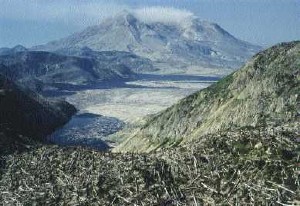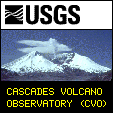Mount St. Helens National Volcanic Monument
|
Gifford Pinchot National Forest
Forest Headquarters Cowlitz Valley Mt. Adams Mount St. Helens National Volcanic Monument Monument Headquarters Coldwater Ridge Visitor Center Johnston Ridge Observatory Mount St. Helens
|
General Visitor Information
Visit and Discover the Drama of an Active Volcano
 At 8:32 Sunday morning, May 18, 1980, Mount
St. Helens erupted. At 8:32 Sunday morning, May 18, 1980, Mount
St. Helens erupted.Shaken by an earthquake measuring 5.1 on the Richter scale, the north face of this tall symmetrical mountain collapsed in a massive rock debris avalanche. In a few moments this slab of rock and ice slammed into Spirit Lake, crossed a ridge 1,300 feet high, and roared 14 miles down the Toutle River. The avalanche rapidly released pressurized gases within the volcano. A tremendous lateral explosion ripped through the avalanche and developed into a turbulent, stone-filled wind that swept over ridges and toppled trees. Nearly 150 square miles of forest was blown over or left dead and standing. |
At the same time a mushroom-shaped column of ash rose thousands of feet skyward and drifted downwind, turning day into night as dark, gray ash fell over eastern Washington and beyond. Wet, cement-like slurries of rock and mud scoured all sides of the volcano. Searing flows of pumice poured from the crater. The eruption lasted 9 hours, but Mount St. Helens and the surrounding landscape were dramatically changed within moments.
A vast, gray landscape lay where once the forested slopes of Mount St. Helens grew. In 1982 the President and Congress created the 110,000-acre National Volcanic Monument for research, recreation, and education. Inside the Monument, the environment is left to respond naturally to the disturbance.
 Scientists and visitors follow the changes in
the landscape and the volcano. Surviving plants and animals rise out of the ash,
colonizing plants catch hold of the earth, birds and animals find a niche in a
different forest on the slopes of Mount St. Helens. Scientists and visitors follow the changes in
the landscape and the volcano. Surviving plants and animals rise out of the ash,
colonizing plants catch hold of the earth, birds and animals find a niche in a
different forest on the slopes of Mount St. Helens.The volcano continued to erupt until 1986, violently at first, then quietly building a lava dome. Thick pasty lava eruptions oozed out, each one piling on top of the next, like pancakes in a sloppy pile. The lava dome is now 920 feet high. The United States Geological Survey scientists continue to monitor the volcano for earthquakes, swelling, and gas emissions. |
 Numerous viewpoints and miles of trails have been created
for you to explore by car and foot. During the summer Forest Interpreters lead
a wide range of activities, from short walks to amphitheater presentations, to
help you understand and enjoy this area. Discover the wonder of winter at Mount
St. Helens, where many cross-country ski and snowmobile trails have been created
for you. Numerous viewpoints and miles of trails have been created
for you to explore by car and foot. During the summer Forest Interpreters lead
a wide range of activities, from short walks to amphitheater presentations, to
help you understand and enjoy this area. Discover the wonder of winter at Mount
St. Helens, where many cross-country ski and snowmobile trails have been created
for you. Each year thousands of climbers make the journey to the crater rim. Permits are required above 4,800 feet year-round. Click here to obtain more information about the climbing program. You can now travel on the east, south and west sides of the mountain. On the west side of the mountain, State Road 504 allows access to five Visitor Centers. |
- The Mount St. Helens National Volcanic Monument Visitor Center at Silver Lake is located at mile post 5 on highway 504. This visitor center shows the eruption on May 18, 1980, and talks about volcanoes in general.
- The County owned Visitor Center at Hoffstadt Bluffs is located at milepost 27. This visitor center has a unique gift shop offering merchandise hand crafted from Mount St. Helens ash and a variety of other unique items from around the area.
- The Forest Learning Center, located at milepost 33.5, is operated by Weyerhaeuser in conjunction with the Rocky Mountain Elk Foundation. This Visitor Center leads you through the steps that were taken to salvage the downed lumber and reforest the area. It is possible to take a look through telescopes mounted at the top of their interpretive trail and have the chance to see any elk that may be in the vicinity.
- The Coldwater Ridge Visitor Center is located at milepost 43. This Visitor Center is operated by the Forest Service and is used as an educational guide showing how change come about after an eruption. There is a short trail, "Winds of Change" that is self-guided and shows what happened on May 18, 1980.
- Johnston Ridge Visitor Center is opened in May, 1997. This is the closest Visitor Center to Mount St. Helens and you can look into the Crater and see the dome.
- In April 1996 Congress passed the Omnibus Rescissions and
Appropriation Act (PL 104-134) establishing the Recreation Fee Demonstration Program. This law authorized the Forest Service to test
collecting, retaining, and reinvesting new admission and user fees at up to 50
selected demonstration areas around the country. Mount St. Helens National Volcanic
Monument was selected as one of 10 pilot areas in the Pacific Northwest Region.
USDA Forest Service
Gifford Pinchot National Forest - Vancouver, WA
Mount St. Helens National Volcanic Monument - Amboy, WA
Last Modified: Tuesday, 28 September 2004 at 12:15:03 EDT